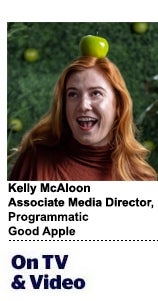“On TV & Video” is a column exploring opportunities and challenges in advanced TV and video.
Today’s column is by Kelly McAloon, associate media director of programmatic at Good Apple.
Pharma’s digital transformation has accelerated media spending on video across devices. Both vertical and video spending in the healthcare and pharma sectors are expected to increase YoY by 11% and 19%, respectively. With shifting media consumption habits, media buyers are testing and experimenting with different combinations to maintain visibility and engage key audiences. It’s trial and error.
But media buyers in the pharma space have the additional challenge of needing to adhere to numerous regulations, including required disclaimers and clickouts embedded in assets.
In a space where every campaign requires precise targeting and numerous legal considerations, adhering to the four-part framework below can maximize engagement and efficiency.
Create platform-agnostic assets
No matter the vertical, short-form videos allow for better scale and more efficient performance. More specifically, assets under 60 seconds have the most available inventory. But running a short-form video can be difficult for pharma, particularly for prescription brands requiring disclaimers that interfere with length.
QR codes or customized CTAs can be effective work-arounds that encourage users to visit the site while still making room for important safety information on-screen. If only one video asset is available, use the highest common denominator specs to create a video that will work across multiple screens.
Well-rounded reach across patients and physicians can be achieved with a mix of CTV and non-CTV (mobile/desktop/tablet). CTV’s one-to-many medium is best suited for reaching patients, but technical advancements will soon enable more precise targeting for healthcare providers across TV screens as well. Longer-form videos, meanwhile, can work well for non-CTV channels.
Consider video-first ad servers
Long-form videos often need to be VPAID-compatible since they require clickouts and brand-safety blocking tags. Audit ad server video capabilities to determine whether VPAID assets with multiple clickouts can function properly.
Be smart about the targeting
Precise, condition-based targeting in pharma advertising is essential. But patients are more than their condition. Advertisers need to consider other signals.
Not every partner can ingest health data segments, and although they’re an integral part of any pharma campaign, they tend not to be as efficient. In order to combat this and maintain a well-rounded targeting strategy, use segments based on TV viewership, social media shares and other lifestyle-related inputs.
Prep for the cookieless future now, even though deprecation has been delayed. Verify that providers are using privacy-safe, opted-in audience sources that rely on alternate forms of identifiers and a healthy mix of data types (second party, zero party and/or first party).
Tailor measurement to individual campaigns
The disclaimer language that comes with branded pharma videos reduces the likelihood of a consumer watching the entire video. If completed views are the priority KPI, opt for non-skippable and CTV environments.
The length of the asset and unique campaign goals can determine which metrics are the best indicators of performance. Maybe the KPI shouldn’t be a completed view, but instead a view through key brand messaging.
Video advertising may be tougher for pharma and healthcare than for other industries, but it’s equally promising – and ripe with opportunity. Don’t be afraid to experiment with various channels to find the right mix.
Follow Good Apple (@GoodApple_) and AdExchanger (@adexchanger) on Twitter.













